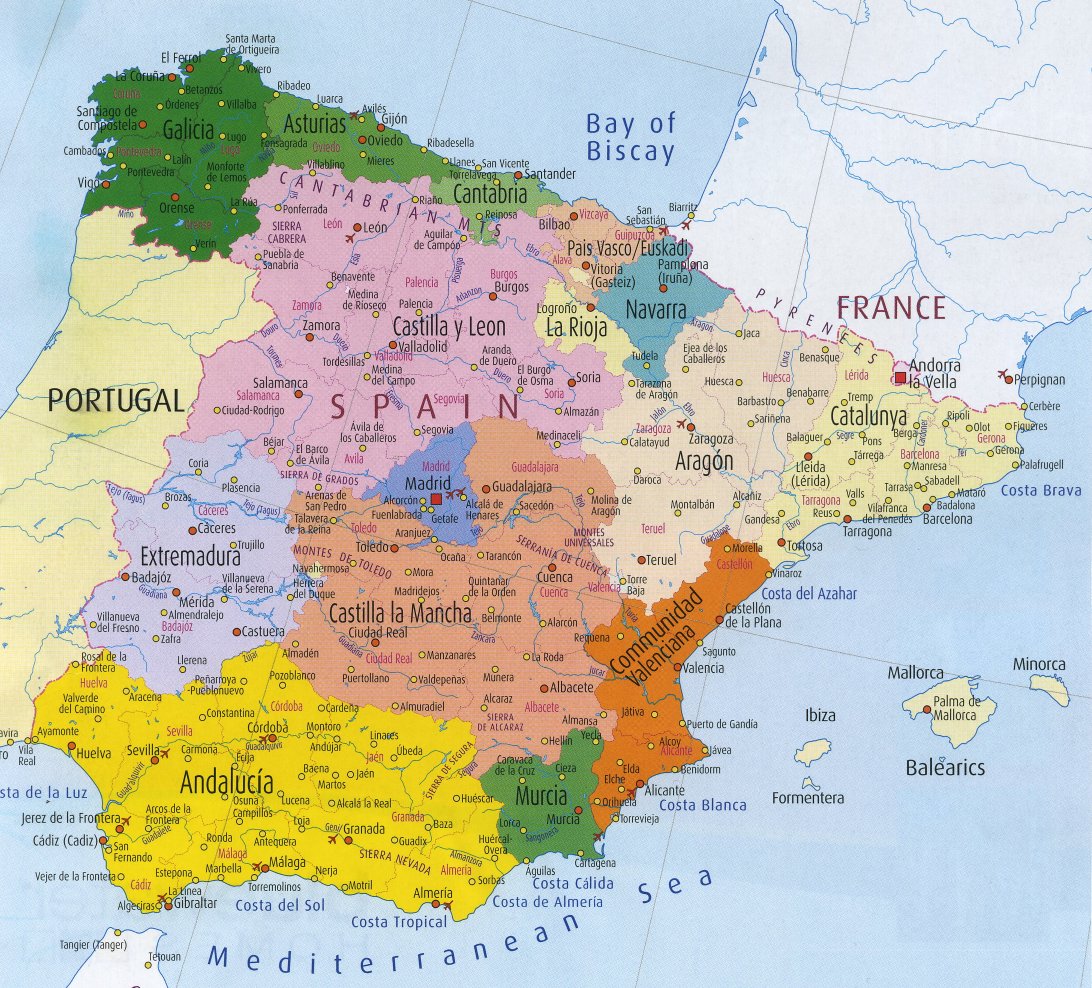Spanish Tax Guide: Tax Implications of Living, Working and Investing in Spain
Spanish Tax Guide – this is the first in our country tax guide series.
Spain emerged from five years of recession in mid-2013, and now is one of the hottest investment options around. Real estate and investment markets are still priced near the bottom, but are on the upswing, employment is improving, and the government’s austerity measures are growing the economy.
Spain’s economy, the fourth-largest in the EU after Germany, France and Italy, crashed in 2008 when a real-estate boom went bust, taking down much of its banking system and raising doubts about the country’s solvency. The gross domestic product, which briefly rebounded in 2010 and 2011, has shrunk 7.5% in the past five years.
Investing in Spain is still not for the faint of heart. Its tax system is one of the most complex in the world, still boasts one of the highest rates in Europe, faces staggering budget deficits which have resulting in “wealth taxes” for residents and nonresidents alike, and the economic rebuilding has just begun. In an interview with The Wall Street Journal, Spain’s Prime Minister Mariano Rajoy said “Spain is out of recession but not out of the crisis,” cautiously touting the effects of budgetary and structural overhauls that have been among the deepest in the euro zone. “The task now is to achieve a vigorous recovery that allows us to create jobs.”
There are strong signs of recovery, and thus opportunity for international investors. Labor costs have been reduced, exports are on the rise, and the current-account deficit, once 10% of GDP as cheap money poured in to fuel the building boom, has turned to surplus. However, GDP growth is expected to increase by .5% to 1% in 2014.
High corporate and personal taxes on your worldwide income, and possibly your worldwide assets, are a major issues for anyone moving to Spain. Unwilling to cut government spending, Mr. Rajoy’s right-leaning government chose to raise taxes. According to the Cato Institute, “Following the tax increase, Spanish individuals will be paying one of the highest personal income tax rates in Europe. For instance, from 2012 onwards, only Sweden and Belgium, with 56.4% and 53.7%, respectively, will have a higher top marginal income tax rate than Spain, which stands at 52%. However, if one takes into account local surcharges imposed by some Spanish regional governments, the top marginal rates rise further. In Catalonia, for example, the top tax rate is 56%.”
For just about any income, Spanish tax rates are higher than in France, Britain, Italy and Germany, they say, adding:
“All of those countries enjoy a considerably higher income per capita than Spain and thus can more easily withstand higher taxes than a poorer country. With Rajoy’s tax hike, Spain suffers from the worst of both worlds: very high taxes combined with decreasing income and employment levels. At 23%, Spain has the highest unemployment rate in the European Union.”
Spain’s immensely complex tax regime means that the well organized and researched resident entrepreneur might take advantage of a number of planning opportunities. While Spain has one of the highest tax rates in the EU, it has one of the lowest effective tax rates. The official corporate tax rate, for example, is 30% but large Spanish companies pay about 8% on average. This compares favorably to the US effective corporate rate of 12.6% for 2013.
- There are few planning options available to non-residents…who basically pay a 21% flat tax without deductions.
Spanish Tax Primer
A resident of Spain is liable for tax on their worldwide income at scale rates after any available allowances and deductions. A non-resident of Spain is liable for Spanish income tax only on Spanish income, and possibly Spanish assets, generally at fixed rates with no allowances for deductions.
If you spend more than 183 days in Spain during the calendar year, or your “center of economic or vital interest” is in Spain, you are a resident for tax purposes. Depending on where you live, personal income tax on wage and business income will range from 24.35% to 56%.
- “Vital interests” usually refers to someone whose spouse lives in Spain and they are not legally separated, and/or their dependent minor children live in Spain.
If you are a tax resident of Spain, income “derived from savings,” such as interest income and capital gains, are taxed at 21% to 27%. Specifically:
- Up to €6,000: 21%
- Excess from €6,000 up to €24,000: 25%
- Excess from €24,000: 27%
By comparison, non-residents pay 21% on capital gains and 24.75% on investment income earned in Spain. Where residents are taxed on their worldwide income, nonresidents are taxed only on income earned in country.
As a tax resident, you might also get the joy of paying a wealth tax on your worldwide assets. This levy varies from year to year and has come and gone in various forms since 2008. In 2014, each person is generally allowed assets of €700,000 and a personal residence of €300,000, so a husband and wife might be able to hold up to €2 million before paying the wealth tax. If you are caught up in this toll, you will be required to pay a tax equal to 0.2% to 2.5% of your total assets.
Spain’s wealth tax is quite complicated, varies from region to region, has been repealed and brought back from the dead more than once, and might finally be eliminated in 2015. In some areas, allowances are reduced and, if you are fortunate enough to live in Madrid, you pay no wealth tax at all…I guess that’s where the politicians call home. If you are at risk of the wealth tax, you should contact a local expert.
Taxation of Real Estate for Residents and Non Residents
If you are a tax resident and own a rental property in Spain, net income earned is taxed at ordinary rates, which are 24.35% to 56% rate. You are allowed to deduct ordinary and necessary expenses, which include interest on loans used to acquire the property, repairs and maintenance, leasing fees, etc. Spain allows you to depreciate the value of the home or structure on the land at up to 2 – 3% of the purchase price, but you may not depreciate the value of the land. 3% results in a depreciation rate similar to the United States (33.3 years in Spain compared to 27.5 years in the US) and more “generous” that the 40 year depreciation schedule Americans are allowed for foreign property.
If you are not a tax resident and own rental properties in Spain, net income is taxed at a rate of 24.75%. If you are not a resident of the EU nor a resident of Spain (ie. you are a US resident for tax purposes), you may not deduct any expenses against your rental income.
If you are not a resident of Spain, you pay 21% in capital gains tax on the profits from the sale of your real estate and 24.75% on other types of investment income. But, be careful because local capital gains tax (which is levied by the town hall where the property is located and depends on local values) may also apply. This should be considered before making a purchase.
- 3% of the gross sale price is held back by the buyer and paid over to the Spanish tax authorities. If 3% of the gross is more than 21% of the net (more than the total tax due), you can file a claim for refund.
In addition to the tax on net rental income, you will pay property tax at 1% to 2% per year based on the value of the property. This rate varies by municipality and you should take it in to account when considering properties from different areas. You should also look in to whether you must pay cantonal property tax in addition to the general property tax described above.
There is also a special assessment on real estate owned by non-residents. If you are not a tax resident of Spain, you will pay 3% per year on the value of the property for the right to own property in Spain.
When you go to sell the property, you will pay capital gains tax as described above. Because Spain’s capital gains rate is equal to or higher than the United States, you will probably not owe capital gains tax to Uncle Sam on the transaction. This is because, in most situations, the Foreign Tax Credit will come in and eliminate a double tax.
- For information on how to report foreign real estate on your U.S. tax return, please see my article, US Tax Breaks for Foreign Real Estate.
Spain will also hit you with a Stamp Duty on the transfer. In most cases, this is 0.5% rising to 1% in some autonomous regions and can reach up to 6%! It is paid by the buyer, but you should take it in to account when valuing your property. A property with a small duty might garner a higher price than one with a 6% toll.
Finally, if you own significant real estate in Spain, and you are not a tax resident, you may still get to pay the wealth tax on your assets in Spain. That’s right, if you own rental properties worth more than €700,000 in 2014, you are required to pay a tax based on their value. The levy starts at 0.2% and jumps to 2.5% quickly. It is uncertain whether this tax will apply after 2014.
Taxation of Rural Land
Many of these taxes do not apply to rural land (land primarily dedicated to farming). For example, transfers of rural land and used buildings on that land are exempt from the 21% tax described above. Used for this purpose means that the building is transferred for the second or subsequent time, except when the building is acquired for rehabilitation, and the property is classified as rural by the taxing authorizes.
In many cases, the transfer of rural land will be taxed at around 7% and property taxes will apply at 2% per year. Though, this is an estimate and can vary by region. You should seek the advice of a local attorney before purchasing rural land…and be aware that is extremely difficult to obtain a permit to build in land zoned as rural.
Tax Summary
As a resident living and working in Spain, you are facing personal income rates that cap at an astounding 57% and capital gains taxed at 21% to 27%. However, you can make use of a number of deductions and exclusions that may get your effective rate down to that of the UK and France…now, there’s something to aspire to in tax planning!
If you are a non-resident, you will enjoy a 21% to 24.75% flat tax with very few deductions (unless you are an EU resident). When you consider that owning rental properties in the US generally reduce your taxes (mortgage interest, expenses and accelerated depreciation often exceed rental income), rather than increasing them as is the case in Spain for a nonresident, one should think long and hard before buying a Spanish rental.
As a non-resident, you will also pay a special 3% tax per year, and a property tax of 1% to 2%. Therefore, a non-resident’s carrying costs may be as high as 5% of the assessed value each year.
When you purchase real estate in Spain, the buyer is responsible for a scaled transfer tax of 8 – 10%, and this usually jumps to 12% for new builds (property acquired from the builder / developer). When you sell the property, you pay 21% on the net gain plus an average stamp duty of 1.5%. Local and municipal taxes may also apply.
Finally, when a non-resident sells their property, a special 3% withholding on the total sale price must be held back by the buyer.
I hope you have found this tax review helpful. I’d like to end with an interesting caveat in the Spanish tax code:
- Because of the extremely high transfer taxes, buyers and sellers might be incentivized to misreport the sale price, with the buyer giving cash on the side to the seller to make up the difference. Well, if the tax authority can prove that the transfer was reported at less than 50% of its fair market value, the government has the right to buy that property for the value reported in the sale.
I hope you find this article helpful. Please contact me at info@premieroffshore.com with any questions or article requests.












Leave a Reply
Want to join the discussion?Feel free to contribute!